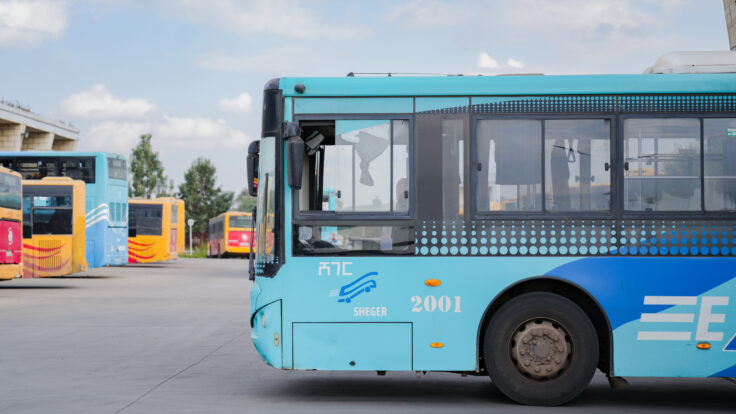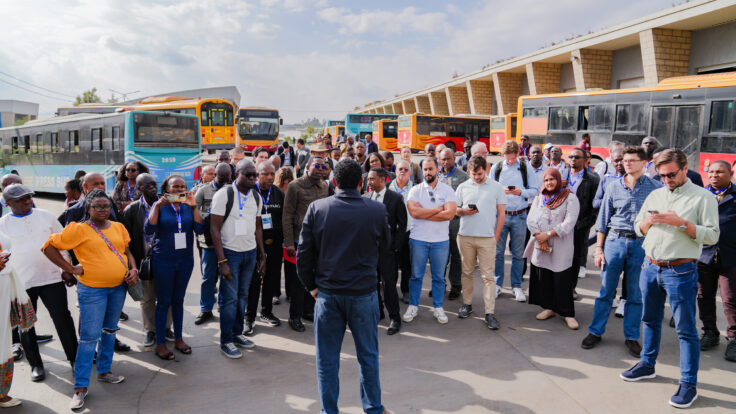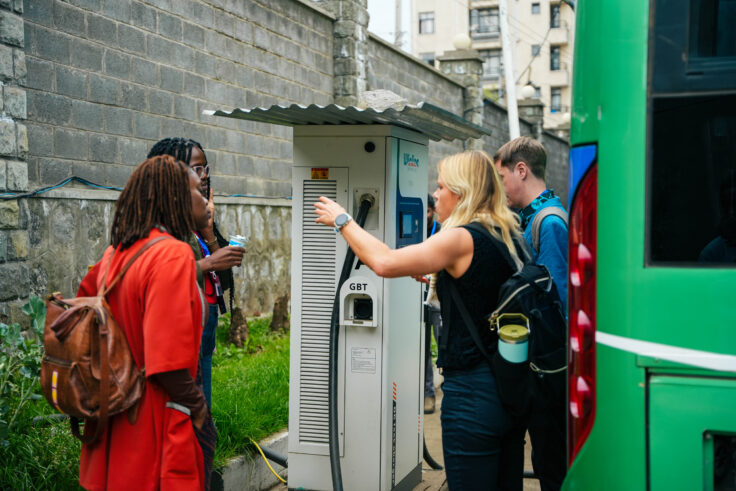November 25, 2025
Inside Africa E-Mobility Week with ITDP Africa
East Africa is standing at the crossroads of a transportation revolution.
Learn more about our regional work at ITDP Africa.
As urban populations surge and climate challenges intensify, the question is no longer if electric mobility will take root; it’s how fast we can scale it. The stakes are high: cleaner air, reduced emissions, and a thriving green economy. And Addis Ababa is showing the continent what is possible. During Africa E-Mobility Week this October, the ITDP Africa team hosted an industry tour of transport facilities across Addis Ababa, offering a unique glimpse into the city’s growing e-mobility ecosystem. This was not just a tourist attraction, but a vision of the region’s transport future, where e-bus fleets can be scaled, charging infrastructure powered by renewable energy, and new industries can boost jobs and economies.

Africa’s E-Mobility Surge
Africa’s electric mobility market is accelerating at an unprecedented pace. Over 30,000 electric vehicles are now active across Africa, with growth rates soaring. Electric two- and three-wheelers grew 38% year-over-year; e-buses surged 44%, and electric cars rose 28%. In addition, Africa’s EV market was valued at USD $15.6 billion in 2023 and is projected to reach USD $28.3 billion by 2030. The EV charging market is further expected to skyrocket from USD $31.9 million in 2022 to $256.5 million by 2030.
Ethiopia is pioneering electric bus services by introducing 100 locally assembled electric buses into operation, setting a strong example for the region. Furthermore, Ethiopia’s landmark ban on the import of diesel and fuel-powered vehicles reinforces the region’s commitment to a transformative future for mobility systems. Countries like Kenya, with companies such as BasiGo, are also innovating in electric bus business models, while Rwanda is removing import taxes to accelerate adoption. Africa is poised to become a global leader in electromobility if the right policies and actions are put in place.

ITDP Africa’s Industry Tour
E-Mobility Week was hosted in collaboration with the Ethiopian Ministry of Transport & Logistics, AfEMA, and UNEP, bringing together 135 participants from around the world. The event explores cutting-edge vehicle technologies, policy frameworks, financing mechanisms, and business models. ITDP Africa hosted an industry tour that brought together key stakeholders from government agencies, private sector players, and development partners to offer first-hand insights into the operational landscape of e-bus systems, charging infrastructure, light rail integration, public transport bus depot management, and traffic management in the capital. The initiative was part of broader efforts to strengthen knowledge exchange, cross-sectoral collaboration, and further interest in sustainable public transport, particularly around e-buses.
The tour began at ITDP Africa’s offices at Nile Source Building, where participants were welcomed with opening remarks and an introduction to the day’s activities. Two separate routes were organized to maximize learning opportunities and ensure participants experienced a wide range of operational sites. Route 1 covered the Anbessa Garage charging station, the Addis Ababa Traffic Management Control Centre, the BKG vehicle assembly plant in Gelan, the Addis Ababa city Kality bus depot, and the Kality light rail station. Route 2 included the same traffic management and charging station stops but focused on Dodai’s e-two-wheeler assembly at Hana Mariam, the Shegole bus depot, and St. George light rail station.

Throughout the tour, participants observed real-time operations and innovations shaping Addis Ababa’s mobility sector. At charging stations and bus depots, they witnessed the integration of modern infrastructure supporting daily e-bus operations, including maintenance facilities and energy management systems. Visits to BKG and Dodai highlighted the city’s growing capacity for local vehicle assembly—both buses and two-wheelers—demonstrating the potential of domestic manufacturing to support e-mobility expansion. As the team traveled through the corridors, they also observed the new walking and cycling facilities being developed in the city.
Meanwhile, the Traffic Management Control Centre offered a glimpse into how advanced traffic systems are helping to improve urban traffic flow, enhance road safety, and coordinate transport services more efficiently. Another significant aspect of the tour was the focus on multimodal integration. The stops at Kality and St. George light rail stations illustrated how e-buses can complement existing rail infrastructure to provide more efficient, sustainable, and accessible public transport. Participants discussed opportunities to improve connectivity between modes and how this could support the broader vision of a clean, reliable, and integrated public transport system for Addis Ababa.
Watch this highlight video on the E-Mobility Week’s Industry Tours.
While Addis Ababa’s progress is inspiring, scaling electromobility across East Africa will require bolder policies, innovative financing, and more public-private collaboration. Governments must incentivize adoption; private companies must invest in infrastructure; and development partners should support knowledge exchange. Electric mobility isn’t just about replacing diesel engines with batteries or even the technology itself. Instead, the transition signals a significant opportunity to reshape urban space through sustainable mobility that improves air quality and public health, spurs economic opportunity and job access, and promotes energy independence from foreign fuels.
This year’s Africa E-Mobility Week demonstrated the progress and possibilities for a sustainable urban future across the region’s fast-growing cities.
